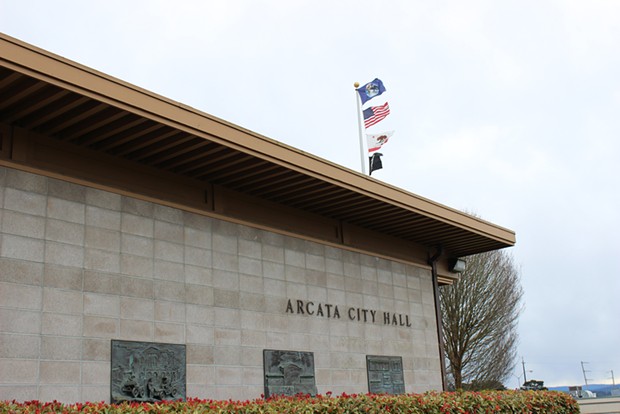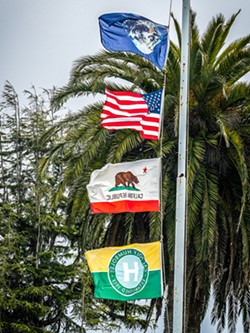'A Symbolic Gesture'
The Earth flag's ascension in Arcata raises unprecedented legal and constitutional questions
By Kimberly Wear [email protected] @kimberly_wear[
{
"name": "Top Stories Video Pair",
"insertPoint": "7",
"component": "17087298",
"parentWrapperClass": "fdn-ads-inline-content-block",
"requiredCountToDisplay": "1"
}
]
On the morning of Dec. 16, the Earth flag was raised to the top of city-owned flagpoles in Arcata, above the United States and California flags, respectively.
The unprecedented arrangement came after the Arcata City Council voted unanimously in closed session the night before to uphold a voter-approved initiative dictating the new placement but with the caveat that the city would also seek a "judicial resolution" on whether Measure M conflicts with state or federal law.
In a news release announcing the Earth flag's ascension, Mayor Sarah Schaefer said the city council "wanted to honor the important ballot initiative process and the will of our voters."
At the same time, she said, the council recognized Measure M passed by what Schaefer described as a "very small margin," with a final vote of 3,051 to 2,781, or around 52 percent in favor.
"Many people, including the city attorney's independent analysis, concluded that the measure was incongruent with state code. Many residents have expressed their concerns over the potential cost to defend the measure from an outside lawsuit," the mayor stated, adding that the city would be asking the courts to "efficiently review the ballot initiative and to assist the city in resolving the questions of its legality in relation to state flag code."
While seemingly straightforward on the surface — requiring a flag bearing the "Blue Marble'' image of the Earth photographed from the Apollo 17 mission in 1972 be displayed atop all others — Measure M is taking Arcata into uncharted legal territory.
The initiative is believed to be the only of its kind in the United States, not only in dispatching the traditional protocol of flying the American flag above all others but by enacting a local law as a symbolic gesture, in this case expressing an opinion of Arcatans that the well-being of the Earth needs to be prioritized.
Measure M also appears to place Arcata — a general law city bound to adhere to California law — in conflict with at least two state statutes that dictate the order of how flags "shall" be flown, raising concerns about the potential of a legal challenge.
Now the city is preparing to ask a Humboldt County Superior Court judge to preemptively decide the matter by requesting what's known as a declaratory judgment to resolve the legal uncertainty, which is expected to be filed this week.
"Based on our research, it is my opinion that the city is caught between conflicting state and federal laws, state election laws that require the city to implement voter approved initiative measures, and state and federal laws that require the city to fly the United States flag at the top of its flagpoles," City Attorney Nancy Diamond said in an email to the Journal. "Although there are court decisions resolving the legality of certain types of initiative measures, there are no cases that we have yet found directly relevant to the flag situation."
With potential litigation a concern, she said, the city council "decided to proactively ask the Humboldt County Superior Court to resolve the conflict for us now, rather than waiting to be sued."
"Specifically, we will ask the Humboldt County Superior Court to make a legal determination of which of the competing laws (election laws vs. laws regulating how the U.S. flag is flown) that the city is required to follow," Diamond said.
Dave Meserve, a former Arcata City Councilmember who led the Measure M campaign, said he doesn't oppose the city seeking the court's counsel and has conveyed to City Manager Karen Diemer "that, as proponents, we want to cooperate with the city in any way possible."
"The whole theme of this has been trying to cooperate with the city to make it as inexpensive and easy as possible to go through this process," he said, noting it's a better course than an outside lawsuit brought by, for instance, a national veterans organization.
The proponents are being represented pro bono by local attorney Eric Kirk.
Putting the Earth flag on top, as the ballot language states, is not meant to disrespect the United States flag, Meserve said, but to push a conversation about the climate crisis and other threats to the global community, and the need to focus on the health and safety of the planet as a whole.
He said the local Veterans for Peace chapter has been supportive of the effort.
"What we are doing is expressing speech, an opinion about the situation on Earth, and that's what we've said all along, that flags are symbols and this is a symbolic gesture to raise awareness," he said.
While going door-to-door and soliciting signatures to place Measure M on the ballot, Meserve said his gauge was that the majority of people were in favor of placing the Earth flag on top. Those who weren't, he said, fell into several camps, including some who thought it was trivial and questioned bothering with an initiative instead of actually taking action to fight climate change. The largest "no" group, Meserve said, expressed concern about potential legal expenses for the city.
In his view, the legality issue seemed to have been in a holding pattern until representatives of the American Legion Arcata Post 274 presented a letter to the council last month requesting the United States flag be restored atop of the flagpole at the Arcata Plaza, a veterans' memorial donated by the post to the city in 1957.
The letter starts off by stating the passage of Measure M was "painful to our members" and many "were offended and downright angry." It goes on to say the issue is not with the Earth flag, which is displayed at the post's hall, but the placement. And, while the members respect the "will of the people," they believe many voters were not aware the plaza flagpole was a memorial to those who served their country in the Armed Forces.
Meserve said he thinks the American Legion's letter might have acted as a trigger to push the city forward in seeking the court's guidance.
"There were several different viewpoints represented in the no votes," he said. "It's not as if all the no votes were people deeply offended by the American flag not being on top."
Los Angeles-based public interest attorney and law professor Tracy Westen, who founded the nonprofit, nonpartisan Center for Governmental Studies that researched state policy, said legal questions raised by the measure are potentially complex. Theoretically, Westen said, they could have far-reaching consequences on decades-old First Amendment protections set down by the nation's highest court governing treatment of the American flag, including acts that others find offensive.
"It's a complicated issue," he said. "I don't think there is a clear answer right now."
On one level, he said, there is the "reasonably simple" concept of a "clash between state law and local law" in which cases, he noted, generally "state law wins."
"There are no special benefits that apply to Arcata, that I'm aware of, so the flagpole is city property and the state says you've got to put the U.S. flag first and the California flag second and that seems to be it," Westen said.
To illustrate the point, he asked: What if voters passed an initiative giving people the right to use any room in city hall any way they want?
"The city would say, 'That's our property, you can't do that,'" Westen said. "In this case, they could argue the flagpole is our property and we're obligated to put the U.S. flag on top of the state flag and that's the end of the story."
But things get more complex if the First Amendment is brought into the mix, Westen said, noting the U.S. Supreme Court has dealt with a few flag cases in the past, the most significant being Texas vs. Johnson in 1989, which — in a 5-4 decision with impassioned arguments on both sides — found that burning an American flag in protest is protected free speech as a "symbolic gesture and symbolic gestures are also covered, protected, by the First Amendment."
"It might be possible that the citizens that passed the ballot initiative say, "Yes, the flag is on public property but it's imbued with symbolic features, that's why — for instance — the state government wants or the national government wants the U.S. flag on top," Westen said, emphasizing he was theorizing on possible legal approaches. "Why does [the government] want that? For symbolic purposes: We're part of a larger nation and that's the most important thing and you're a subsection of that, so we put the California flag below that. But the fact that they are making laws like that is a concession that flags are imbued with symbolic purpose.
"If that is the case, there are free speech issues involved with this case and if the citizens vote that they want the Earth flag on top to show that the Earth is the most critical issue these days ... our ballot measure is imbued with aspects of First Amendment protected speech," Westen said, continuing the hypothetical argument proponents could make. "The First Amendment is guaranteed in the California Constitution and the California Constitution is clear that the people of California have First Amendment rights ... and we're exercising one of those, and if burning the flag is protected, then, for God's sake, positioning the Earth flag above the U.S. flag to show that we're all part of one global entity, that certainly has to be protected."
Whether it would be successful, Westen said, is speculative, noting "it would be a new issue and I don't know of any law on that yet."
"Does a group of citizens collectively have a free speech right to require their government to put up the Earth flag on top of the U.S. flag?" Westen asked. "It's a tough argument to make, but they might make it. ... It might be a better route than trying to argue that the state can't preempt a local Arcata decision."
The Texas vs. Johnson decision, Westen said, was considered "shocking and a lot of people think it was wrong." If the Measure M case somehow gets before the U.S. Supreme Court on a First Amendment argument, he said the likelihood is not only would it be rejected but the court's current conservative majority could also potentially look to revisit and reverse the flag burning decision.
"They are very conservative and are reaching out aggressively to change the law," Westen said, noting the recent overturning of Roe vs. Wade.
Another complicating factor is Arcata's status as a general law city.
Cal Poly Humboldt Political Science Department Chair Joice Chang explained that a general law city, like a charter city, has "the authority" to act locally, but differ in the latitudes each has to "govern municipal affairs."
"A general law city is bound by the 'general law' of the state of California, which includes the California Constitution, state statutes, state regulations and relevant judicial decisions, whereas a charter city adopts a 'charter' (which must be approved by voters) that outlines how the city will be organized," she wrote in an email to the Journal. "In addition, a charter city has authority to pass laws regarding municipal affairs that can be different from state statutes, so long as they are consistent with U.S. and California Constitutions."
A general law city, however, is bound by state statutes on numerous levels from how elections are conducted and qualifications for serving on the city council to using a city manager form of government as opposed to a "strong mayor" form, which charter cities can adopt.
That's where the two state statutes Diamond cited in her impartial analysis on Measure M come into play.
Those are the California Government code on flag display, which states, in part: "At all times the National Flag shall be placed in the position of first honor." The other is a section of California Military and Veterans Code, which includes the provision: "No other flag or pennant shall be placed above, or if on the same level, to the right of the Flag of the United States of America, except during church services, when the church flag may be flown."
In contrast, the U.S. Flag code uses more demure language.
"The federal law uses 'should' while the state laws use 'shall' when referring to the position of the U.S. flag on the flag pole," Chang said. "This may lead to some more complications. On the one hand, one could argue that the Supremacy Clause of the U.S. Constitution (Article VI, Paragraph 2) could mean that the federal law preempts the state laws. On the other hand, preemption happens when the federal and state laws clearly conflict with each other. Here, the use of 'should' versus 'shall' may not be enough to argue that there is a conflict.
"In addition, when it is not clear that a conflict exists, courts tend to prefer interpretation that avoid preempting state laws," Chang continued. "Similarly, state laws will usually preempt local laws that are deemed to be [in] conflict. However, unless the relevant state law expressly prohibits a local ordinance, courts will presume that the latter is not preempted by the state law. It is important to remember that there is no easy answer to when laws are [in] conflict and when preemption should occur at any level."
Meserve acknowledged Arcata's status as a general law city aspect could present a sticking point, adding he had tried to explore the idea of moving Arcata toward becoming a charter law city when he was on the council to allow more flexibility, but said it is a complex and expensive process.
In the end, he said, proponents are happy to see the Earth flag now flying at the top of city flagpoles.
"I think it is conveying the idea that you can only have a healthy nation if you have a healthy Earth," Meserve said.
As for the city moving the issue into the court realm, he said "in an ideal world, in my point of view, I would just like to see the Earth flag continuing to wave at the top."
"But if this is the process the council thinks is necessary, let's do it."
Kimberly Wear (she/her) is the Journal's digital editor. Reach her at (707) 442-1300, extension 323, or kim@ northcoastjournal.com.
Comments (6)
Showing 1-6 of 6
more from the author
-
Dust to Dust
The green burial movement looks to set down roots in Humboldt County
- Apr 11, 2024
-
Our Last Best Chance
- Apr 11, 2024
-
Judge Rules Arcata Can't Put Earth Flag on Top
- Apr 5, 2024
- More »
Latest in News
Readers also liked…
-
Through Mark Larson's Lens
A local photographer's favorite images of 2022 in Humboldt
- Jan 5, 2023
-
'To Celebrate Our Sovereignty'
Yurok Tribe to host gathering honoring 'ultimate river warrior' on the anniversary of the U.S. Supreme Court ruling that changed everything
- Jun 8, 2023



































